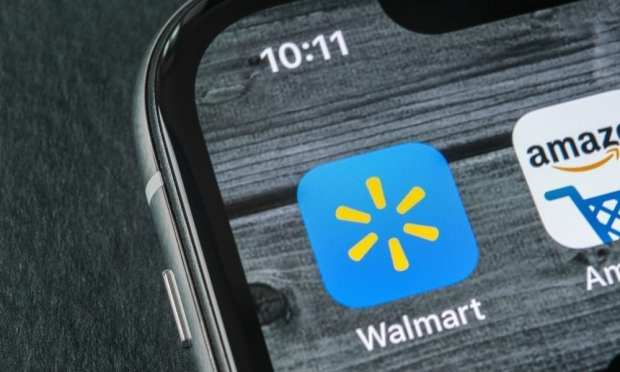Walmart Amazon Whole Paycheck Tracker: Big Payments Upgrades, New Reviews And A Second Life For An Old Brand

It was something of an uneven week in the race for the consumer’s whole paycheck. Amazon had a something of a forward-backward kind of week, as an argument emerged about whether its algorithm is rigged in such a way that it is getting an extra (and illicit) leg up in the race. But it also made some great leaps forward this week, particularly in empowering cash-only customers to join the era of eCommerce.
Walmart’s pace was steadier this week, but also rather slower. It too had a big payments play to lead off with, as well as its ongoing efforts to develop the larger family of Walmart connected brands.
It was an active week on all sides, albeit somewhat more so at Amazon, as the pace of the race is getting faster as fall officially begins.
Amazon
Big Play of the Week: A New Way To Pay With Cash On Amazon
While their numbers are shrinking every year, there is and likely always will be a dedicated cadre of cash-only customers. And this week, Amazon expanded its efforts to bring them into the digital fold.
Starting this week in the U.S., consumers who prefer cash payments can leverage the Amazon PayCode at checkout and then pay with cash at any of Western Union’s 15,000 locations, according to an announcement.
“We’re constantly innovating to improve the shopping experience on behalf of our customers, and are proud to expand Amazon PayCode to customers in the U.S.,” Ben Volk, director, payments at Amazon, said in the announcement. “Customers have told us they love the convenience of paying in cash. Together with Western Union, we’re able to offer customers more shopping choices, enabling them to pay for their online purchases in a way that is convenient for them.”
Once an order is placed shoppers have 24 hours following the time that the order is placed to make a payment. If a return occurs, shoppers will get a cash refund at a participating Western Union agent location for orders made via Amazon PayCode once a return is received.
“As one of the world’s largest digital and physical money movers, we’re innovating our service to give customers more access and choice,” Western Union, Consumer Money Transfer President Khalid Fellahi said in the announcement. “We’re embracing the complexity of a world where cash and digital payments are likely to coexist far into the future. We are providing easy solutions for customers who want access to the convenience of online shopping but prefer to pay in-person.”
The new move is Amazon’s latest — but not first — move on the cash-based customer. This week, Amazon also announced that Amazon Cash (which allows consumers to load cash directly into their Amazon account) is now located in more than 100,000 cash-loading locations around the country.
Scuffle of the Week: The Argument Over Algorithms
Is Amazon tweaking its algorithm to give its own profits an edge in the consumer search process? That is the big question posed in The Wall Street Journal this week — whether by including “profitability” as one of the factors the algorithm searches for, Amazon has, either knowingly or not, found a way to push its own products higher in the ranks the algorithm spits back.
People related to the project told the news outlet that Amazon “optimized the secret algorithm” in its search results to feature the products Amazon would most benefit from instead of ranking the bestsellers and most relevant items. So far the new algorithm had not been publicized. Amazon executives and the company’s search team A9 have reportedly been squabbling over the change for the better part of a year.
A change to Amazon’s search algorithm is a big deal for the site’s sellers, as the position of products on a page can greatly affect sales. Most people make buying decisions based on first-page search results, according to analytics firm Jumpshot.
Amazon, for its part, denies the charges.
“We have not changed the criteria we use to rank search results to include profitability,” Amazon spokeswoman Angie Newman said in an emailed statement to WSJ.
That official denial was followed up with a statement on Twitter that accused the WSJ’s “anonymous sources” for getting the information wrong.
“@WSJ story based on anonymous sources is wrong,” the company tweeted on Monday (Sept. 16). “We have not changed the criteria we use to rank search results to include profitability. We feature products customers want, regardless of whether they are our own brands or products offered by our selling partners.”
Given Amazon’s current antitrust issues with U.S. regulators, the accusation comes at a suboptimal time.
But then, where there are negative headlines, there is usually an effort by Amazon to boost the trustworthiness of its marketplace and the products it curates to the top of consumers’ lists. And this week was no exception.
Commerce Upgrades: A Boost for the Review Section
Amazon is testing an easier way for customers to leave feedback on purchased items. Instead of the old method, where a consumer has to create a full written review, Amazon is testing a “click-and-go” option for customers who want to leave feedback, but don’t want to write a full explanation.
“We are testing a feature that allows customers to leave feedback easily while also helping shoppers get authentic customer ratings on products from a broader set of shoppers,” an Amazon spokesperson said.
The one-tap reviews will be accessible from a number of places, including the “Your Orders” page, on product pages or by responding to a query from Amazon when a customer logs in. To review, the customer simply clicks on a star and then a green check confirms the choice. There is also the option to come back later to write out a review or add a photo or video.
The one-tap reviews will be tested online and on mobile apps. Amazon stressed that the new feature is not yet a permanent fixture. We imagine that if it can boost the number of reliable reviews it gets, it has a good chance of becoming one.
And speaking of new features …
Walmart
Big Play of the Week: The Capitol One Walmart Card Is (Almost) Here
Next week, Sept. 24 to be specific, the new Capital One Walmart credit cards are arriving — a Mastercard and the private-label Walmart Rewards Card. Users will be getting beefed-up benefits from the card: 5 percent back on everything purchased for the first year, either on Walmart.com or inside the store using Walmart Pay, and 2 percent in store and 5 percent online after the first year.
The Mastercard branded version gives back 2 percent on restaurant and travel purchases. There is no annual fee or charges for transactions when the cardholder is in another country.
“Walmart’s mission has always been to help customers save money so that they can live better, and our new credit card program — which both helps customers earn more when paying for things in and outside of Walmart, and offers many other incredible benefits — is squarely aligned with that mission,” said Daniel Eckert, senior vice president, Walmart services and digital acceleration. “As our company has evolved to serve customers shopping in stores, online and on the Walmart apps, we also recognized the need to fully, digitally enable the cardholder experience; that’s why we’ve worked with Capital One to make it possible for cardholders to manage essentially every interaction with the program right from the palm of their hands.”
Revival of the Week: Scoop’s Second Act
As part of its ongoing efforts to expand as a fashion destination, Walmart announced this week it has obtained the rights to the Scoop name and is bringing back the brand.
The company is relaunching the Scoop NYC brand in some of its brick-and-mortar locations and on its website, CNBC reported. Scoop Founder Stefani Greenfield is reportedly part of the redesign process. With the relaunch, Walmart will sell over 100 pieces priced from around $15 to about $65 for a coat. The pieces will use materials such as vegan leather and faux fur, with selections including clothes, handbags and footwear.
Scoop went under three year ago, despite a brief spike in popularity after its logo appeared in “Sex and the City” episodes as well as on the arms of fashion influencers. All 16 of its stores closed, and things looked finished for the nearly 20-year old firm.
“We’ve been focused on establishing Walmart as a destination for fashion — a place where our customers can discover stylish items that are accessible,” Denise Incandela, the head of Walmart’s fashion business, said in a web post. “Adding Scoop to our portfolio makes it that much easier for our customers to look and feel their best.”
There are second acts in American fashion after all.
Whether Scoop will be enough to up Walmart’s fashion cache, and give it a boost in the ongoing race against Amazon, remains to be seen. And, of course, where one of the racers advances, the other usually moves to catch up pretty quickly — so we’ll keep our eye on Amazon fashion.
Along with logistics, AI, grocery and the rest of it. Because that’s the fun part of the race for the consumer’s whole paycheck — you never really know where the race is running next.
